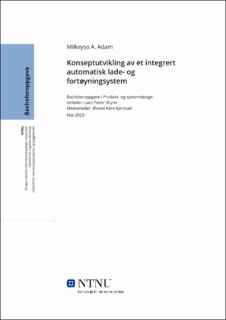Konseptutvikling av et integrert automatisk lade- og fortøyningsystem
| dc.contributor.advisor | Bryne, Lars Petter | |
| dc.contributor.advisor | Kjerstad, Øivind Kåre | |
| dc.contributor.author | Adam, Milkeyso Abdujalil | |
| dc.date.accessioned | 2023-07-15T17:21:53Z | |
| dc.date.available | 2023-07-15T17:21:53Z | |
| dc.date.issued | 2023 | |
| dc.identifier | no.ntnu:inspera:146720209:148644035 | |
| dc.identifier.uri | https://hdl.handle.net/11250/3079466 | |
| dc.description.abstract | Automatiske lade- og fortøyningsystemer ble først tatt i bruk for over 10 år siden men det er ikke før nå at anvendelsen har begynt utbre seg og teknologien utvikles raskt. Skipsfarten er på vei mot en elektrifisert og autonom framtid. Det økende behovet for fullautomatiserte systemer har bidratt til vekst i behovet for smarte lade- og fortøyningsløsninger, spesielt innenfor ferge- og hurtigbåtsektoren. Gjennom arbeidet med prosjektet Grønn Kai har det oppstått et behov for å fortøye og lade opp en powerbarge. Denne powerbargen er planlagt til å seile i Geirangerfjorden med energi lagret i roterende svinghjul for å forsyne nullutslippsfartøy. I denne oppgaven har det blitt designet et konsept for et lade- og fortøyningsystem som er tilpasset powerbargen. Konseptet består hovedsakelig av vakuumteknologi som brukes til fortøyning og induksjonsteknologi som brukes til lading. I tillegg til de nevnte automatiske systemene brukes det statiske løsninger for stabilisering av fartøyet. Ettersom denne oppgaven er en del av det større prosjektet Grønn Kai som skal realiseres er det blitt gjennomført en økonomisk analyse av konseptet. Som et alternativ for konseptet med induksjonslading og vakuumfortøyning har det også blitt utarbeidet en mer økonomisk løsning for ladesystemet hvor det benyttes konvensjonell kontakt kobling. Det alternative konseptet har lavere investeringskostnad men høyere driftskostnader. I den økonomiske analysen har konseptene blitt sammenlignet for å avgjøre hvem av dem som vil være det mest lønnsomme alternative i et større tidsperspektiv. | |
| dc.description.abstract | Automatic charging and mooring systems were first introduced for over 10 years ago, but it is only now that their use has begun to increase, and the technology has started to develop rapidly. The vessel industry is moving towards an electrified and autonomous future. The increasing need for fully automated systems has contributed to growth of smart charging and mooring solutions, especially in the ferry and fast-boat sector. Through the work on the Green Quay project, there has arisen a need to moor and charge a powerbarge. This powerbarge is planned to sail in the Geirangerfjord with energy stored in rotating flywheels to supply electric zero-emission vessels. In this thesis, a concept has been designed for a charging and mooring system that is customized for the powerbarge. The concept mainly consists of vacuum technology used for mooring and induction technology used for charging. In addition to the mentioned automatic systems, static solutions are used to stabilize the vessel. As the thesis is part of the larger Green Quay project that is to be realized, an economic analysis of the concept has been carried out. As an alternative to the concept with induction charging and vacuum mooring, a more economical concept which applies the use of a conventional plug-in system has been developed. The alternative solution implies a lower capital expenditure but with a higher operating expenditure. In the economic analysis, the concepts have been compared to determine which of them is the most profitable alternative in a larger time perspective. | |
| dc.language | nob | |
| dc.publisher | NTNU | |
| dc.title | Konseptutvikling av et integrert automatisk lade- og fortøyningsystem | |
| dc.type | Bachelor thesis |
